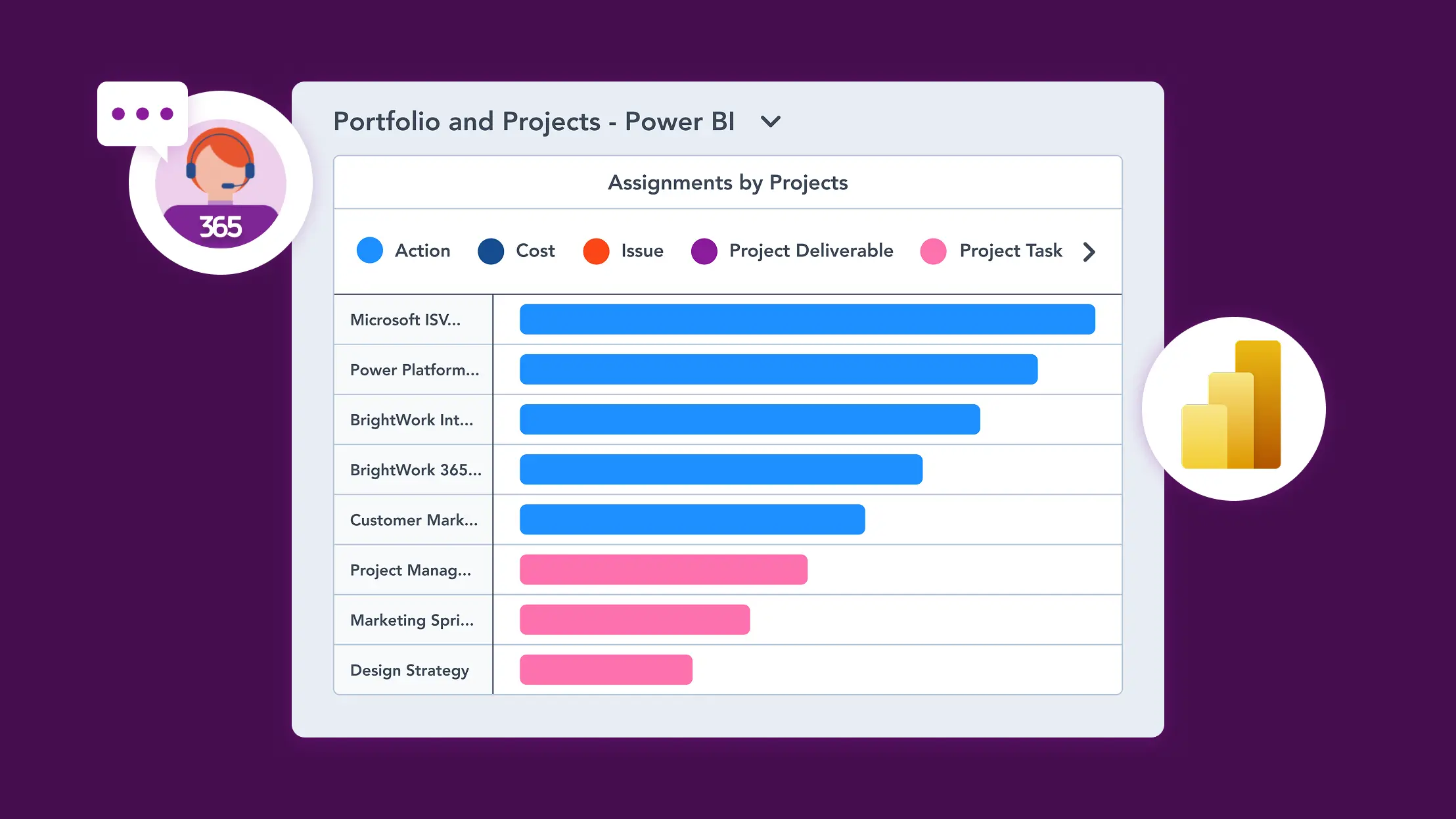Project managers rarely have the luxury of unlimited time, budget, or personnel. That’s why effective resource allocation is essential, not optional, for successful delivery.
In reality, businesses don’t have unlimited resources at their disposal. Resources such as labor, money, tools, and materials are limited and must be allocated and managed effectively for smooth project execution. Effective project management and resource allocation are, therefore, critical skills.
What is Resource Allocation?
Effective resource allocation requires a structured plan and a clear understanding of your entire resource ecosystem, encompassing internal capacity planning, managing external vendors, and forecasting project demands.
Developing a Comprehensive Resource Allocation Plan
Keeping the project goals in mind, project managers identify and assign tasks to employees, stipulating timelines according to their skill level and availability, among other factors. This process often involves strategic resource planning to ensure alignment with overall business objectives.
The Broader Resource Ecosystem
The scope of resources can also include external parties, making skills in managing contractors and consultants increasingly important, alongside considerations for vendor performance management if third-party deliverables are critical.
Depending on how the workload is distributed across the business during the entire project cycle, resources are assigned or reassigned as needed. With the help of accurate resource allocation, PMs know firsthand whether the milestones can be completed within a given timeframe.
As tasks are completed and regular updates accumulate, the future roadmap for the specific project portfolio becomes increasingly clear.
5 Reasons Why Resource Allocation is Essential to Organizations
According to PMI’s most recent Pulse of the Profession report (2024), erroneous requirements gathering remains one of the primary causes of project failure.
Without a clear understanding of the resources required for a project, project managers are likely to fail at drawing accurate assumptions and conducting predictive analysis throughout the project lifecycle.
By simply improving your resource allocation, you can avoid bottlenecks such as project delays and reduce task dependencies, ultimately increasing the likelihood of project success.
Here are 5 ways in which effective resource allocation helps your organization:
1. Reduce Employee Churn
Simply put, employee churn refers to the overall turnover of an organization’s staff as current employees leave and new employees are hired. Effective management of human resources is key here.
When done right, resource allocation ensures employees are allocated tasks/problems they like to do and are good at solving. This encourages them to stay in the company as they do fulfilling work and become more engaged. What’s even better is that you also improve employee billability!
2. Ensure the Timely Delivery of Projects Within Budget
Timely delivery within budget is a win-win for both your business and clients, which helps cement your business’s reputation as a result of successful resource allocation.
When under-skilled and over-skilled resources are improperly assigned to projects, you face time and budget issues. Overqualified employees drive up the project resource costs, whereas your project gets delayed by under-skilled resources.
3. Reduce Project Cost
In the absence of resource allocation, resources are allocated according to immediate visibility, whether they are the best fit or not. Crucial factors such as skill level and job-fitness take the back seat.
Resource allocation addresses this by distributing your resources across processes according to predefined job-matching criteria, thereby increasing your profitability.
4. Help Maintain a Time Log for Employees
For each employee, the time to complete a project varies by a margin. As a PM, you want to prevent employees from both overworking and underworking, as both can hurt productivity and efficiency. This also has a direct impact on employee engagement and requires careful workload management.
A well-maintained time log, often managed through professional timesheets, can help PMs accurately assess the time employees spend on their jobs, understand true resource capacity, and then allocate resources accordingly.
5. Accounts For the Change in Project Scope
PMs have to account for changes in plans for a project. A client can modify the project requirements at any time during the project. New assumptions and learnings in the middle of a project can drive you to redefine the scope of your project, and so on. Understanding the scope creep impact on resources is vital.
To ensure it doesn’t disturb the employee morale and non-human resources, it’s essential to account for the change in project scope in resource allocation so the project is executed without severe bumps.
Common Resource Management Challenges
Before diving into optimization tips, it’s crucial to acknowledge common hurdles. PMs often face resource constraints that can derail delivery timelines, affect team morale, and limit strategic flexibility. Recognising these common issues is the first step toward building a resilient and adaptive project environment.
Overcoming Resource Constraints with Proactive Contingency Planning
Effective strategies involve proactively managing resource scarcity, rather than reacting to it. A well-developed resource contingency plan helps address unforeseen shortages or changes. Resolving resource conflicts swiftly and fairly is essential to maintain team morale and project momentum.
5 Tips to Optimize Your Resources as the Project Proceeds
Optimizing resources is crucial for project managers seeking to deliver projects efficiently and consistently. While having the right people in place is essential, resource optimization goes beyond allocation; it enables you to do more with less.
Resource optimization improves overall project performance by balancing demand with capacity, eliminating inefficiencies, and increasing flexibility across your resource pool.
Here are some ways to achieve resource optimization, including key resource optimization techniques for project management:
1. Encourage your employees to learn multiple skills
Cross-training employees with secondary skills enhances resource flexibility and improves billability across concurrent projects. With management support and adequate training, employees can learn secondary skills. It makes them more billable, and you can allocate your talents wisely from a flexible resource pool on multiple projects.
2. Identify the resources before you begin
Before the project kickoff, ensure that you have adequate resources before undertaking a project. Some factors to consider in your resource allocation plan are:
- Availability of your resources according to their schedule
- The skill level of resources
- The project demands to match
- Expected time delays
- Cost spikes of the project
This planning phase should include elements such as capacity planning and detailed resource forecasting, often starting with a clear work breakdown structure (WBS) to identify all necessary tasks and their corresponding resource needs.
3. Include equipment, materials, and facilities in the resource allocation plan
If your business deals in physical assets, it’s essential to include them in resource allocation along with your employees. An example would be allocating meeting rooms correctly, optimized for meetings and informal sessions.
4. Increase profitability by fully utilizing resources
We have addressed assigning resources in detail; what’s next is ensuring they are fully utilized. One cannot function well without the other. Tracking whether your resources are being held back by non-billable operational tasks and immediately shifting them to strategic, billable work can help you achieve high efficiency through diligent resource utilization tracking.
Techniques to Prevent Overallocation and Improve Efficiency
Techniques such as resource leveling, which aims to balance demand with supply, and resource smoothing, which optimizes resources within float, are crucial for preventing resource overallocation.
Understanding the critical path method can also guide resource decisions, ensuring that vital tasks are never starved for resources, sometimes necessitating resource-limited scheduling.
5. Use Business Intelligence (BI) tools to make better, informed decisions
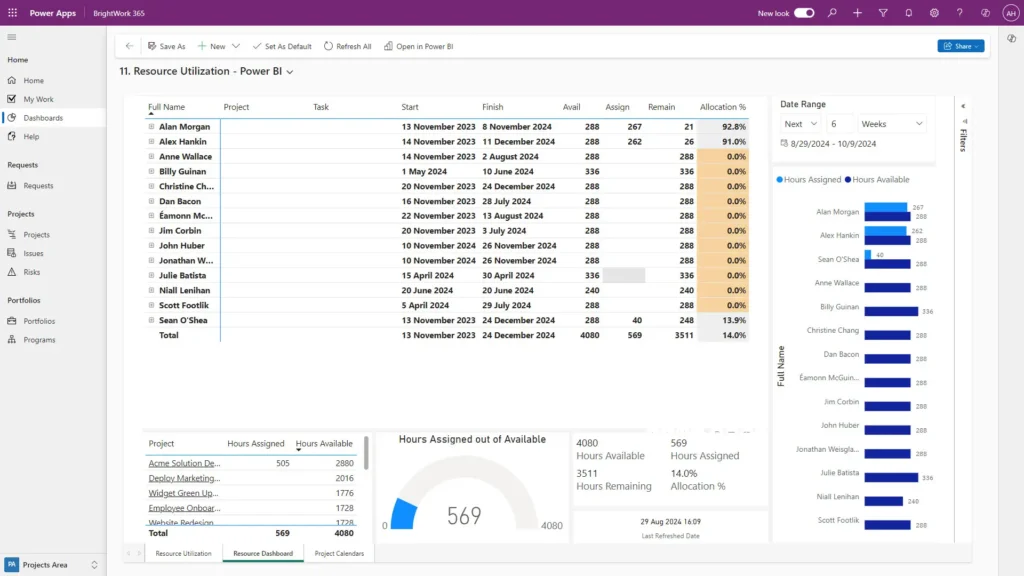
As discussed in the next section, BI tools track your business’s Key Performance Indicators (KPIs) and account for their utilization, availability, and capacity. This provides real-time updates of different KPIs and keeps the decision-makers well-informed.
Tools That Support Strategic Resource Analysis
Often, these BI capabilities are part of a broader resource management software suite, which might also facilitate the use of a resource allocation matrix or a resource breakdown structure (RBS) to manage assignments and track key resource metrics visually.
These capabilities become even more powerful when connected through a platform like Microsoft Power BI. For organizations using BrightWork 365, Power BI provides deep data integration and visual reporting that transforms fragmented project inputs into actionable insights for informed decision-making.
How Power BI Can Improve Resource Allocation
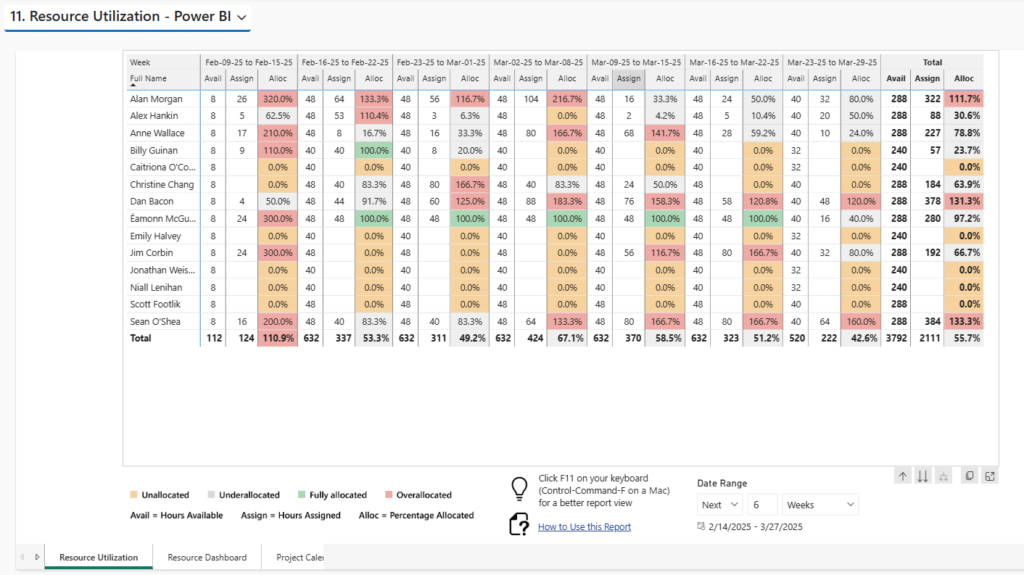
Optimizing project resources for allocation optimization is easier said than done. A flood of data from multiple sources can be overwhelming for even the best project managers, making it crucial to understand how using Power BI for project management can turn this data into actionable insights. Here’s where the traditional methods fail, and Power BI steps in.
What is Power BI? It turns unrelated data from varied sources into understandable insights. They connect Microsoft apps, such as Excel and Dataverse, to non-Microsoft apps, like Salesforce, to analyze data in a single location. They enable the creation of tools that simplify project reports for project managers.
How PMs make decisions with Brightwork 365
Brightwork 365 is a project and portfolio management solution integrated with Microsoft Power BI. It turns incoherent data into accessible dashboards and charts, providing insights that were previously hidden under large amounts of data.
One common example is seeing how different team members are assigned across multiple projects and identifying potential bottlenecks.
Brightwork 365, supported by dedicated Brightwork 365 services, takes it further; PMs can examine “what if” scenarios with data and make forecasts for future performance. This makes sure departments meet their key business metrics. Data visualizations using charts tell stories that were previously hard to find.
What can you do with Brightwork 365?
- Allocate resources
- Track task status
- View filters according to the role (PMs, Sales, etc.)
- Track project schedule
Visualize Resource Capacity and Project Progress with BI Dashboards
Get centralized, real-time insights into tasks, timelines, and workloads across your entire portfolio. These reports help PMs and executives make faster, more informed decisions.
1. Portfolio dashboard – All project activities in one place
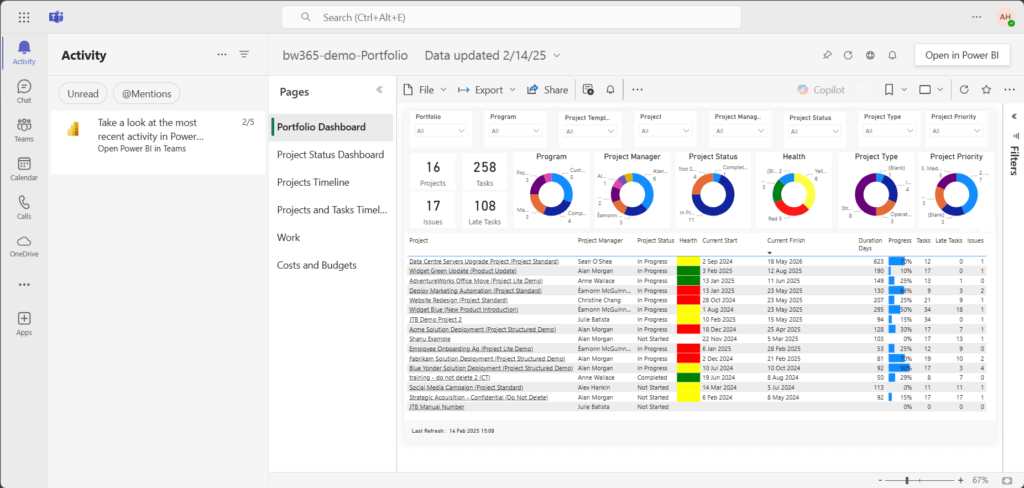
Through the rich dashboard in ‘Portfolio’, a key tool for managing the project portfolio, PMs can see the status, health, issues, and late tasks across all projects in one place. This type of comprehensive view is often referred to as a resource management dashboard.
It’s beneficial when many employees work in parallel on multiple projects. PMs can filter according to Employee, Template, Project, and Portfolio to closely monitor the progress in individual fields.
2. Project timelines
Using an interactive Gantt chart, senior executives and PMO leads can track the schedules for all projects in one place. It’s easy to check the current start and finish dates, as well as the status (underway, late, or overdue) of projects. This completely eliminates the need for manual updates from employees.
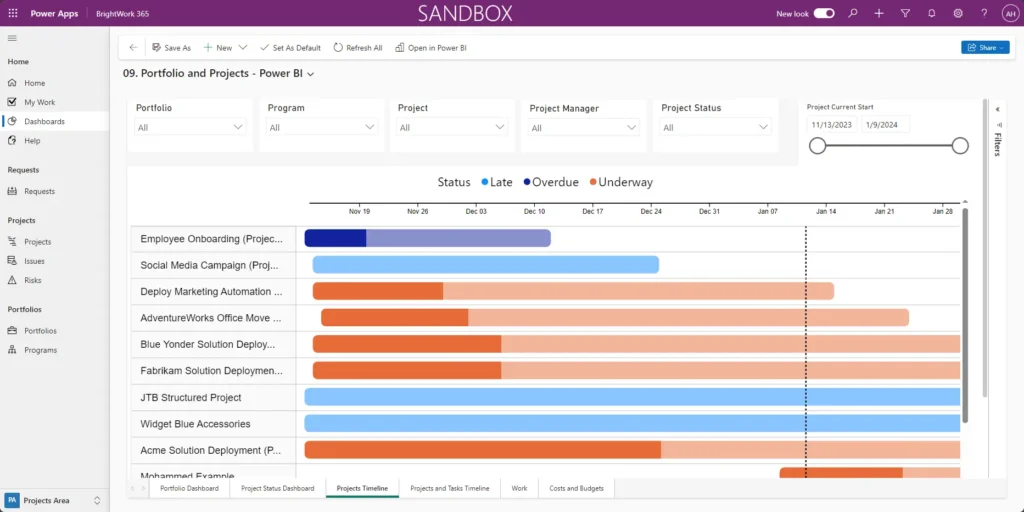
3. All work
PMs can view tasks, deliverables, issues, and risks due across all projects in one place at the ‘All Work’ section. This view helps the entire team to understand and balance work assignments fairly among themselves.
4. My Work
‘My Work’ displays tasks, deliverables, issues, and risks assigned to the individual logged-in user across all projects in one place, giving each team member a clear, centralized view of their responsibilities and deadlines.
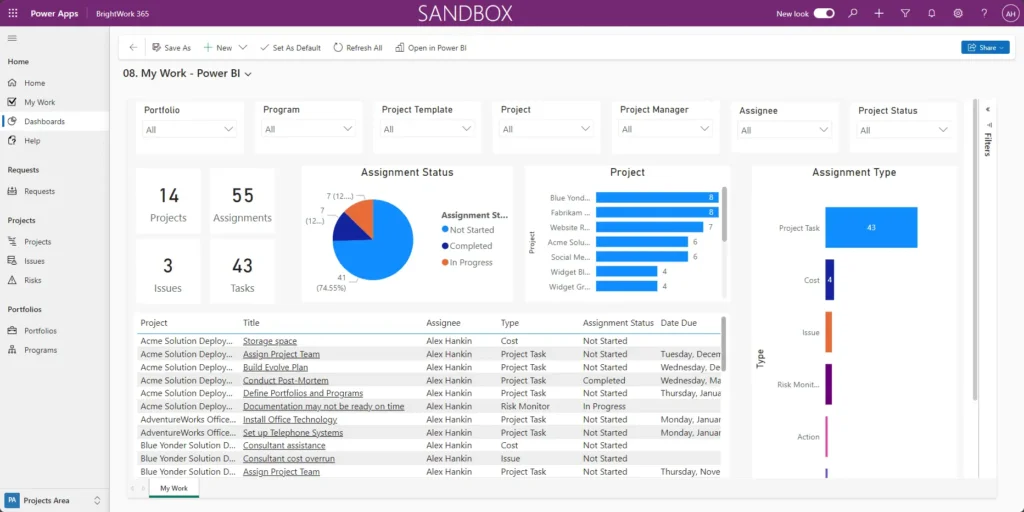
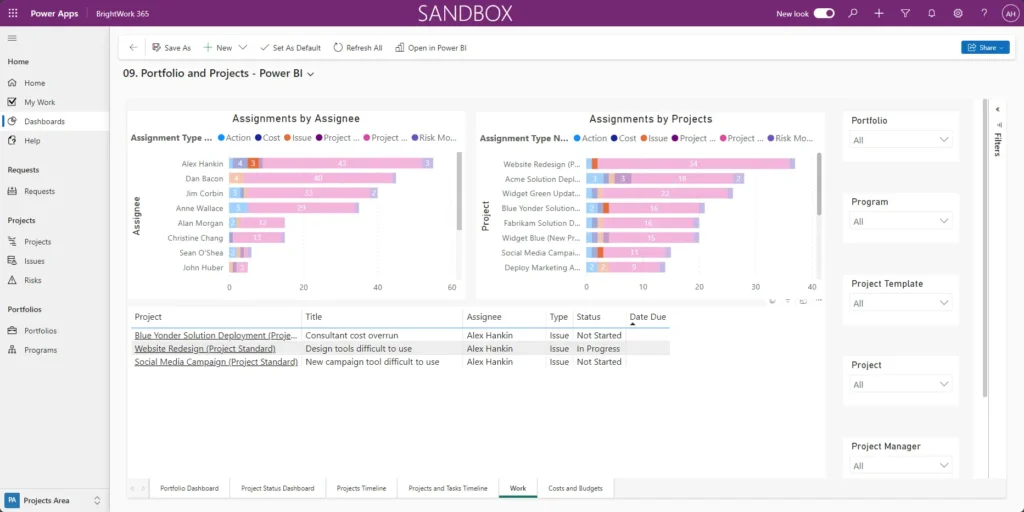
Drive Project Success with a Scalable Solution
BrightWork simplifies complex project and portfolio management challenges by providing structure, visibility, and control within a single, scalable solution that integrates seamlessly with your existing Microsoft 365 environment.
From project initiation to portfolio-level insights, BrightWork ensures teams can confidently manage work, communicate effectively, and report accurately.
With configurable templates, integrated dashboards, and the ability to evolve processes over time, BrightWork adapts to every stage of your project management maturity.
BrightWork Can Help
Whether you’re a project manager juggling competing priorities or a PMO leader aiming to standardize workflows across departments, BrightWork delivers the tools needed to succeed, without overwhelming your team.
Ready to see how BrightWork can streamline your project and portfolio management on Microsoft 365? Contact Us to request a tailored live demo.
